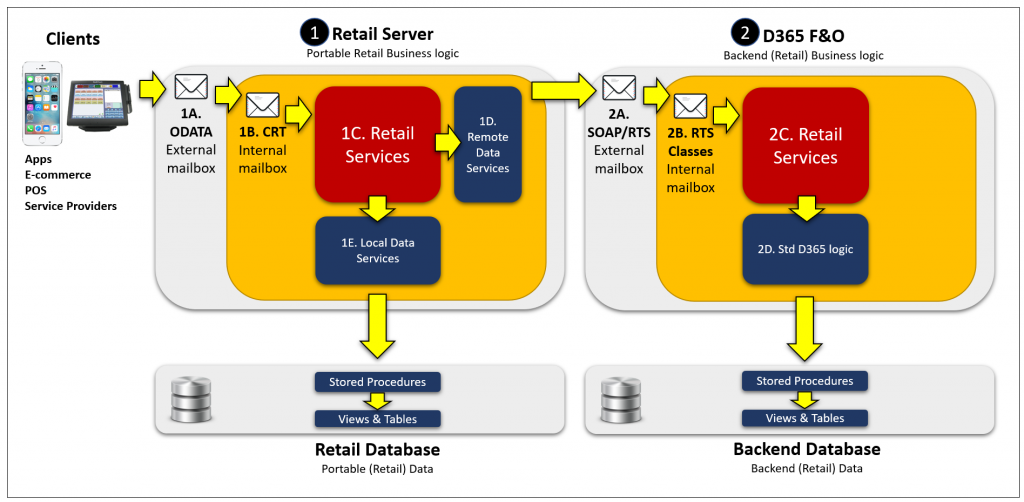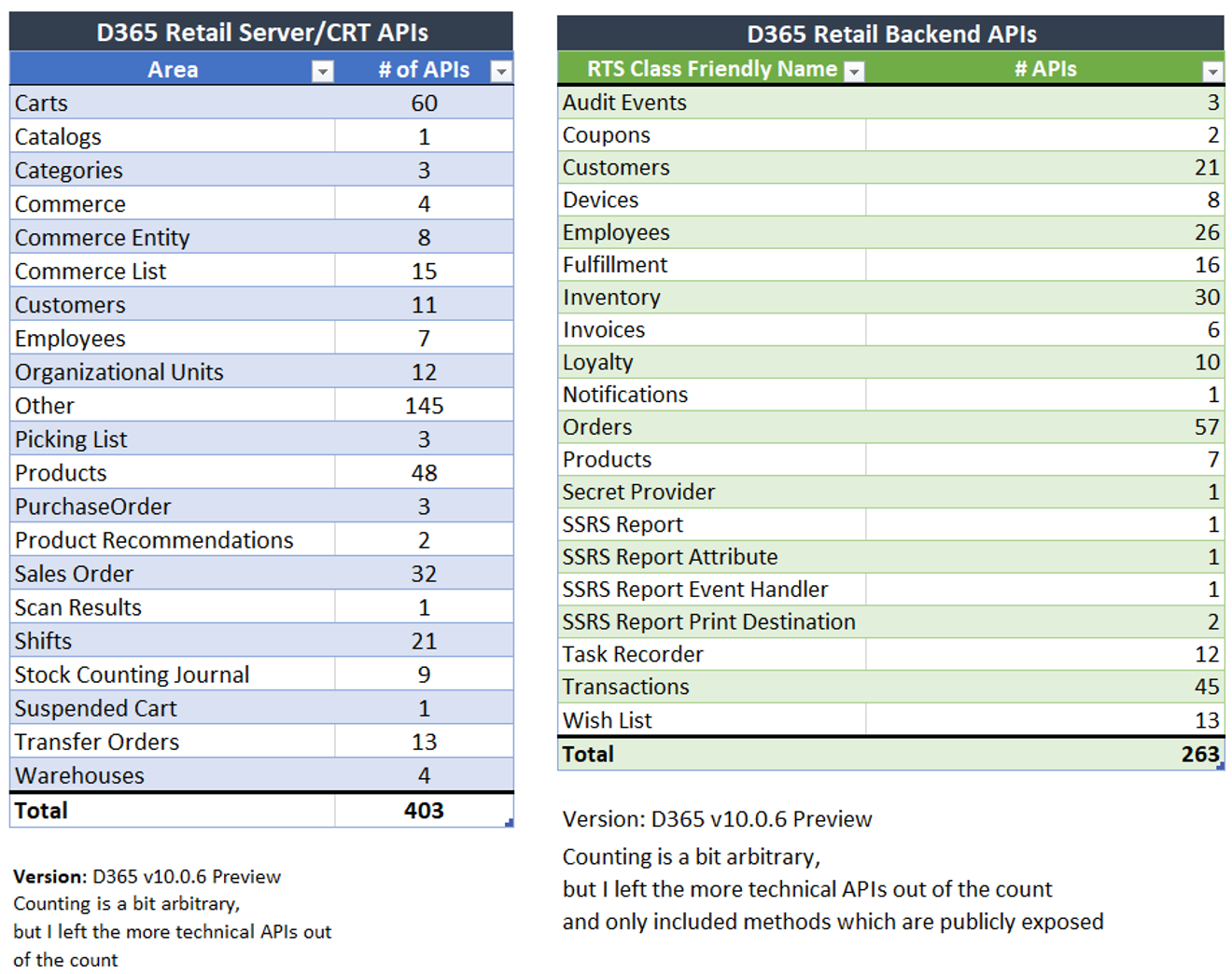Did you know that D365 for Retail contains more than 400 out-of-box Retail APIs (for the non-techies: interfaces) ranging from Loyalty management, Gift card management, Omni order management to Stock counting and Retail Logistics? These interfaces allow you to easily integrate with any 3rd party systems like e-commerce platforms, POS systems and Consumer Apps. It also allows you to quickly enrich your Retail Solution with handy Power Apps, for example for in-store Goods receipt, Stock counting, Labelling or Clienteling.
Unfortunately I still notice that many Customers and Partners do not consider the Retail APIs in their designs, which goes around all the ‘free’ Retail Business Logic which comes with them. Instead, Customers and Partners start a custom coding exercise (re-inventing the wheel!) which often limits rather than empowers the Omni-channel capabilities of D365.
This is all mainly caused by the lack of documentation – It’s time to change that! In this series of blog posts we’ll explore the Power of the Retail API’s so we can all benefit from them by using them to enhance the Retail experience for the Retail Businesses we serve. As we need the non-techies on this journey, I’ll try to make it understandable for all of us. Making the right Architectural decisions starts with a good understanding of the solution. So let’s dive into that first!
1 – D365 Retail API Architecture explained
D365 Retail comes with 3 major components – Below description is a little bit technical, but it’s good to keep these components in mind for a better understanding of the main picture (picture 1) below:

Let’s go through each element in the picture, step-by-step:
- The Letter. An app (e.g. a POS system, e-commerce platform or Power App) can send a request to 1 of the 400+ D365 Retail end points. This request can be to Request information such as the loyalty balance of a customer or to Send information.
- The public Mailbox. Metaphorically you can compare this request with a letter which is dropped into a mailbox. The mailbox in this case is the ODATA end point of Retail Server (1A). It’s a public mailbox, so any App can drop letters in there. But there are 2 prerequisites which need to be met to allow this: the App needs to be a registered ‘member’ in the Receiver’s domain and the App must have received a pre-authorisation code (token) which needs to be sent with the letter.
- The Internal Mailbox. Once successfully received in the public (ODATA) Retail Server mailbox, the letter (request) is forwarded to an internal mailbox: a specific Commerce Run Time (CRT) operation (1B). This CRT operation is responsible for processing the letter. In order to get this done, the CRT operation contacts 1 or multiple Retail Services (1C).
- Processing of the letter. The Retail Services work with subcontractors. There are 2 types of subcontractors: Data services which can read/write information from/to the local Retail Database or Remote Data services which can receive/send information from/to the D365 backend. The Retail Services have been instructed (programmed) to contact either of the subcontractors or both subcontractors to process a certain letter (request). For example, a letter to update the Loyalty Balance for a customer is forwarded to the D365 backend (since other Apps should work against the latest balance) whereas a new customer is created both in the local Retail Database and forwarded to the D365 Backend. In some case the Retail Service has to read specific parameter settings first to determine which subcontractor to forward the work to. These parameters have been set in D365 backend but are locally available for the Retail Services after sync to the local Retail Database. For example, a parameter which controls whether e-com orders are created into the local Retail database (and from there synched to D365 backend in bulk) or whether these orders are forwarded to the D365 backend in real time.
- Another Public mailbox. Remote Data Service ‘Subcontractors’ will drop the original letter in the Public mailbox of the D365 Backend: a SOAP mailbox, often referred to as Real Time Service (2A). This mailbox has a trust relationship with the Remote Data Service ‘subcontractor’ which is confirmed by a certificate.
- Another Internal mailbox. Very much similar to the way Retail Server is organized, the agent looking after the Real Time Service mailbox, forwards the letter to an internal mailbox for processing: the RetailTransactionService class in the D365 Backend (2B). From there, Retail Services in the D365 backend take care of the actual processing which ties into many standard D365 (Retail) classes packed with Business Logic (2C and 2D). For example in case of customer creation, these services will include the customer in the address book of the Retail channel, assign Retail affiliations and Customer attributes. In other words: even though not all this information was part of the original letter, the Retail Services ensure the letter is processed in line with D365 (Retail) Parameters settings and Retail Business Logic.
- Response. As a sender of a letter, you’d love to get a response on your respect, right? This is organized as follows: whenever an exception occurs somewhere across the chain of ‘middlemen’ subcontractors as described above, the exception is written into a response letter which is returned to the sender (the App) following the chain in reverse order. If no exceptions occur, the original letter will reach it’s final destination. There, a response letter is written which is an in-depth response on the actual request, for example a response letter full of information on a newly created customer. Similar to what happens in case of an exception, the response letter is returned to sender following the chain in reverse order.
2. Teaser
In below video I am trying to illustrate how powerful the Retail APIs can be. In the video, I am using Microsoft Forms (an Office 365 App) to capture information as part of an imaginary Customer Sign up process. Power Automate picks up the information and forwards it to D365 Retail Server to create the customer in the D365 backend in real time. As you will see in the video, the standard D365 Retail Business logic is fully utilized here as if the customer was captured on D365 MPOS: for example, the new customer is automatically included in the Retail channel’s address book.
3. The potential
The left Table below provides a break down of the Retail areas the 400+ Retail APIs apply to. A significant number of these APIs are built to provide real time data exchange with the D365 backend. The right table below presents the Retail areas for which real time connectivity to the D365 backend is supported.
Looking at the functional breadth of the Retail APIs and the video in this blog post, I hope you’re inspired to think about all the opportunities provided by the D365 Retail APIs. In upcoming blog posts on this topic, we’ll make deeper dives into the various aspects of these Retail APIs so we can all use this knowledge to further enrich the D365 Retail experience for our customers.


december 10, 2019 @ 08:29
Great overview and compelling trigger to think in a different way when solutioning. Looking forward to your future blog posts.
december 13, 2019 @ 13:48
Thx Van Ran!
december 13, 2019 @ 20:09
Wow. Great information. Simple presentation.
december 16, 2019 @ 05:37
Hi Patrick,
Great work! As you have mentioned that there’s lack of documentation and the reason consultant’s are not able to utilize OOB features.
With your blog, we got to know that there’s a lot more we can do.
Could you please guide me to create customer sign up form with D365 F&O as you have done above under Teaser section?
Best Regards,
Manvendra
december 16, 2019 @ 11:29
Hi Manvendra,
My next blog post will go into full detail on that one – I thought needed to write the 2nd blog post in the series (published last Friday 13.12) to give people the baseline to fully understand how to consume the Retail APIs in part III.
februari 4, 2020 @ 22:26
Hi Manvendra,
To your original question: see the details in Part III of this series (in case you hadn’t seen it yet): https://patrickmouwen.com/technicalint/d365-retail-apis-part-iii-how-to-use-the-d365-retail-apis/
Kind regards,
Patrick